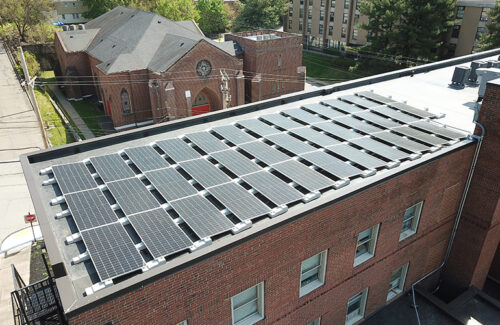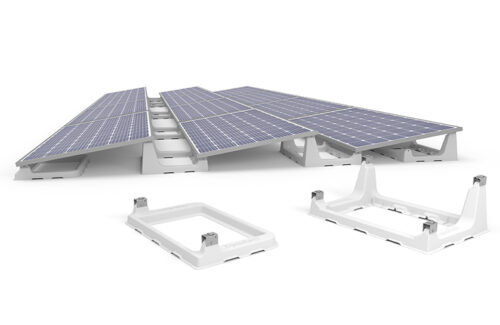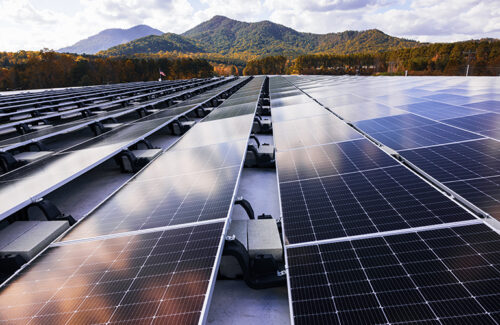
Commercial solar mounting systems surpass steel and aluminum
Edoardo Brignoli, CEO of Sun Ballast USA, stated, "He came up with the idea of integrating ballast and brackets into a single component and began producing them in-house to facilitate installation and improve efficiency. He manufactures the brackets in the morning and installs them in the afternoon."

The Sun Ballast product is a three-piece system: it features three orientations (embedded, east-west, and southward tilt of 5 to 10°), three components (concrete ballast frame, laid rubber mat, and clamping fixture for installation modules), and three weight options (32, 64, and 96 pounds).
The difference between Sun Ballast and ready-mix concrete lies in its curing method. This concrete has a strength of 5,000 psi, which is the standard strength for load-bearing construction projects.
"People have come to realize from painful experiences that not all concrete is created equal," Brinoli said. "We often encounter situations where installers or EPC contractors don't access the roof until ten years after the initial installation, essentially just scooping up sand that was once in blocks but has broken apart over the years due to freeze-thaw cycles.". ”
The company designated the Northeast region as a test site for Sun Ballast to demonstrate its ability to withstand the winter conditions of the area.
"We thought, 'If we can handle New England, we can handle the rest of the country,'" he said.
Sun Ballast is cast domestically. Since concrete is non-conductive, it is awaiting UL 3741 compliance approval—which will allow contractors to meet fire safety requirements without installing rapid shutdown devices on the roof.
Plastic, polymer, and fiberglass shelves
DynoRaxx first entered the solar mounting market in 2007 when the company introduced a steel mounting structure, but its representatives found the assembly process cumbersome. In 2011, the company launched a mounting system made from proprietary molded fiberglass composite. The DynoGrip Evolution flat roof system is a ballasted mount that can be installed without any tools.
The fiberglass material means the rack is not affected by thermal expansion like metal racks. DynoGrip is installed in areas exposed to direct sunlight, featuring UV resistance and fireproof properties, meeting UL 2703 standards. The rack elevates the ballast blocks to a position half an inch away from the roof to facilitate airflow and drainage.
"In most cases, if solar energy is merely retrofitting existing buildings, they actually fail to consider the installation of components and their impact on roof drainage," said Nathan Rizzo, the inventor of the mounting system. "We do not build dams or block the natural water flow of roofs."

In its 14 years on the market, DynoGrip has only undergone one transformation, which is to remove the fiberglass guide rail and replace it with a tool free fixture fixed on an upward support for installing modules.
Rizzo said, "It perfectly embodies the product we originally designed and our goal - it is indeed an evolution of solar energy and does not require a lot of iterations
DynoGrip shelves can be stacked and palletized for simpler logistics.
Sollega's modular trackless rack FastRack also uses a similar transportation method. The first model of FastRack was launched in 2012, initially using high-density polyethylene in trackless modular shelves, and switched to fiberglass reinforced nylon 6 in 2014.
Sollega CEO Elie Rothschild said, "If you carefully observe the car hood, you will find that some components are actually made of the same material. This is because its expansion and contraction are very small, and its thermal stability is very high
FastRack consists of a main frame (or bucket) used to accommodate ballast blocks or mechanically fixed on the roof; Then there are bolts used to tilt the panel 5 °, 6 °, or 10 °; Panel fixtures; And sliding grounding jumper. The lightweight bucket can carry a maximum load of 1700 pounds.
The service life of glass fiber reinforced nylon is between 40 and 50 years, and it is completely recyclable. Rothschild stated that Sollega is considering using post industrial recycled materials to manufacture its shelves, which already have a smaller carbon footprint than extruded metal. In addition, glass fiber reinforced nylon is non-conductive, so FastRack defaults to UL 3741 standard.
Non traditional materials such as concrete, fiberglass, and fiberglass reinforced nylon have certain advantages in the logistics transportation and installation convenience of commercial solar energy, as they can reduce the number of components. Metal remains a popular choice for flat roof projects, but other bracket options also provide installers with alternative methods for solar construction.

© 著作権: 2025 Xiamen Wintop New Energy Tech Co., Ltd.. 全著作権所有.

サポートされているIPv6ネットワーク